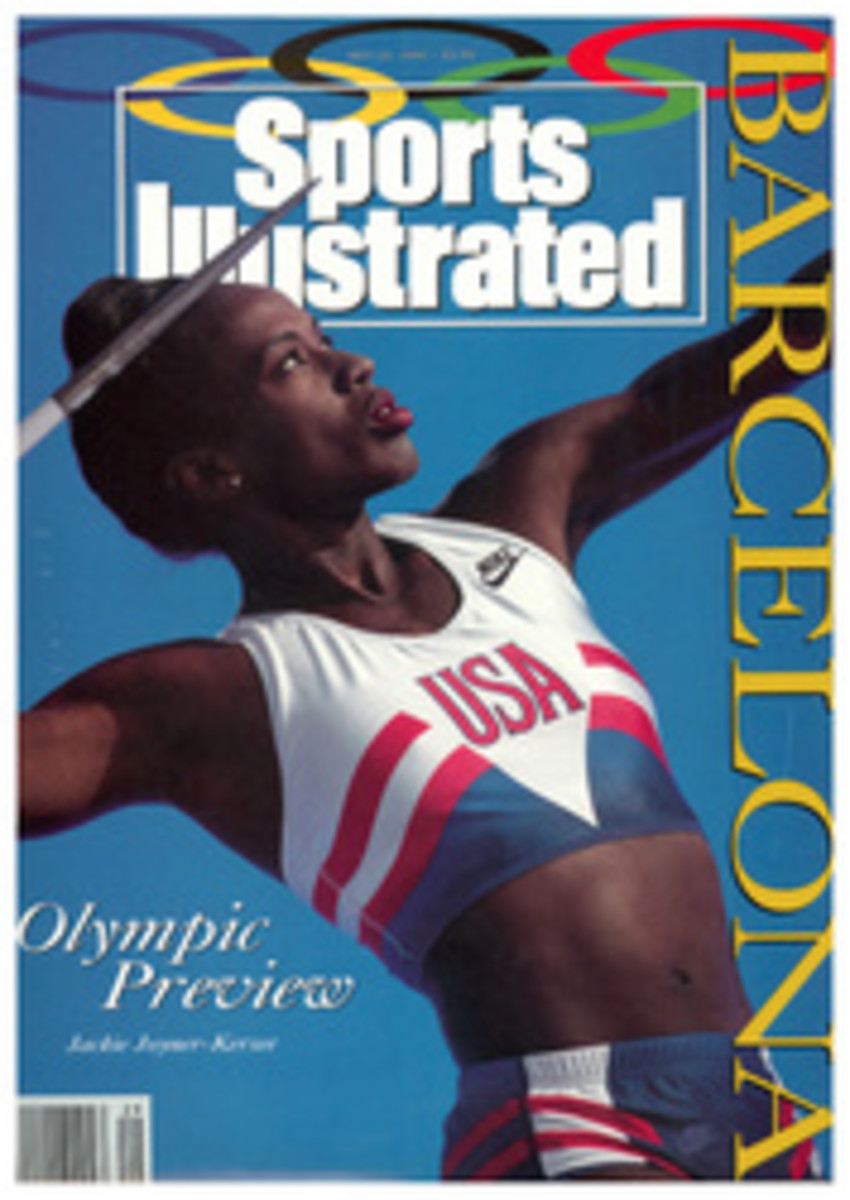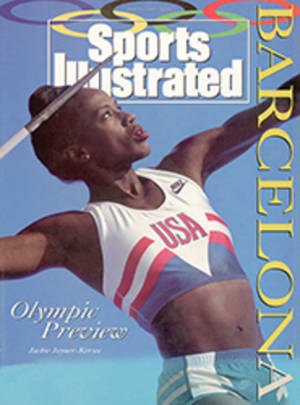
Speed to Burn
It is only now as we slump back in amazement after Roger Kingdom, Greg Foster, Renaldo Nehemiah, Calvin Smith and Edwin Moses all failed to make the 1992 U.S. Olympic track and field team—and after Carl Lewis qualified only in the long jump—that we can really celebrate the extraordinary recent domination of the speed events by American men.
You can stare for a great, long, evocative while at the chart above. It shows the 1992 leaders, the world-record holders and the past decade's world and Olympic champions in the six events whose essence is raw, horizontal velocity: the men's sprints, hurdles and long jump. There are 42 entries in the chart. All but five are filled with the names and marks of Americans. Such dominance has not always been the case. At the '76 Olympics, for example, U.S. men won only two of the six speed events: Moses in the 400-meter hurdles and Arnie Robinson in the long jump. You have to go back to the three Olympics immediately after World War II—in '48, '52 and '56—when the U.S. was practically the only well-fed nation on earth, to find a time in which any country had the sort of sustained hegemony America has enjoyed of late.
Athletic history wasn't supposed to unfold like this. As wealth, good nutrition and leisure spread, as U.S. coaching methods were exported, as foreign talent was recruited and trained by American colleges, it was understood that U.S. speed merchants would face ever more potent competition. And sure enough, in the 1960s and 1970s European and Caribbean runners made increasing inroads into charts such as this.
But a decade ago Americans began to reclaim the lion's share of the chart entries. Of the six world records, only one, for the 200 meters, languishes in foreign hands. Pietro Mennea of Italy ran his 19.72 in 1979 at Mexico City's altitude (7,575 feet). The coholders of the American record, Lewis and Joe DeLoach, each ran 19.75 at sea level, a time that would be at least .10 of a second faster if run through the reduced air density of high altitude. Michael Johnson's 19.79 through the miasma of New Orleans during the '92 U.S. trials would suggest that he is on the verge of giving the U.S. a clean sweep of the record boxes.
Why this resurgence? One factor is that the professionalization of track and field gave incentive to longer careers among American athletes. An Edwin Moses from another era would have won a single gold medal and searched for a job. Instead he became wealthy by staying undefeated in the 400-meter hurdles for 10 years.
Yet money is paid regardless of nationality. And there are a few other factors that seem more cogent in explaining America's ascendancy. Magnificent sprinters happen when a few extraordinarily gifted athletes find their way to experienced, intelligent coaching. Constellations of gifted athletes appear in places such as Jamaica and Nigeria, which are heavy with talent in search of teachers. But they have not appeared in Eastern Europe (one notable exception having been 1972 Olympic 100 and 200 champion Valery Borzov of the Soviet Union), which is rampant with scientist-coaches, all beating the bushes for scarce talent.
And, of course, sprinters appear in abundance in the U.S. The men on this chart are there because they arc on the furthest reaches of human performance. They did what they did because of both talent and happenstance—one thinks of the fortuitous 1979 matching of Lewis with University of Houston coach Tom Tellez—and we best understand them not by seeking social or economic explanations but by simply looking at the men themselves, and remembering, and marveling.
When it comes to gold medals, only one man marches straight across all the Olympic and world-championship listings: Lewis in the 100. He almost does it again in the long jump, going unbeaten all the way to the 1991 world championships. To keep him out of that slot, Mike Powell had to break Bob Beamon's 23-year-old world record of 29'2½" by two inches. Lewis gets two more mentions, for his 1984 200-meter Olympic win and his 100 world record, giving him a grand total of 11. Such sustained achievement has no precedent in sprinting. Not since '06 had a man repeated as Olympic 100 champion until Lewis did in '88, and it was an additional three years until he set the current record of 9.86. Lewis is unquestionably his generation's main man, and he's sick of hearing all this changing-of-the-guard stuff after his, for him, mediocre performance at the U.S. Olympic Trials. He intends to change the guard right back, beginning with the Barcelona long jump, in which he and Powell will duel with each other and, quite possibly, the 30-foot barrier.
In the 200 we choose to remember Calvin Smith. The most mellow of sprinters, he has a sweet, slow smile and, when he runs, a wildly rolling head and a dangerous late rush. Smith held the 100 record at 9.93 for four years and won two 200 world championships. After Canada's Ben Johnson was stripped of his gold medal in Seoul's 100, Smith was moved up to third.
All American sprinters have had to live with being blotted out of the public imagination by Lewis. Smith did it, not ecstatically but with quiet grace.
Lee Evans's 400-meter record of 43.86, set in 1968, stood for 20 years. When Butch Reynolds broke it, in Zurich in '88, it was with the most astounding running performance of the decade. Reynolds has had trouble getting support from fellow athletes in fighting the IAAF, the world track federation, over a seemingly flawed IAAF drug test, in part because his record that night seems so superhuman. "Why do I think Butch took something?" goes the line. "43.29." This may be the most pernicious effect of athletes' drug use on the popular mind. The better a record, the more it is ascribed to steroids. Losing all capacity for genuine awe, we lump the miraculous in with the tainted.
It now seems miraculous that two powerful but brittle athletes combined for so long to control the 110-meter hurdles. Yet Kingdom and Foster leapfrog wonderfully across the chart, Kingdom grabbing the Olympic golds, Foster the intervening world titles. Had Nehemiah not surrendered his best years and his Achilles tendons to his NFL aspirations, the chart would be different.
Four of the 400-meter-hurdles entries are embossed with Moses's name, and that doesn't count his 1976 Olympic gold. The image that returns is from the Helsinki worlds in '83. His shoelace came untied down the backstretch, but he won despite its lashing the hurdles and his legs. "You could have stepped on it and tripped yourself," said a frantic journalist. Moses, the mathematician, was embarrassed for him. "My stride is nine feet," he said. "To trip, I'd have to have a shoelace 10 feet long."
The period of U.S. sprinting dominance has been marked by the absence of the Great Foreign Opponent. When Armin Hary of West Germany won the 1960 Olympic 100 with a fast start and when Borzov won both the 100 and the 200 in Munich in '72, they caused a sensation. The cock-of-the-walk psychology of U.S. sprinters and coaches allowed for little distinction between being humbled and being humiliated. The '76 Olympics were the high-water mark for the international forces, as Hasely Crawford of Trinidad won the 100, Don Quarrie of Jamaica the 200, Alberto Juantorena of Cuba the 400 (and 800) and Guy Drut of France the 110-meter hurdles. Why there were no Americans who could run with them then is just as mystifying as why things are different now.
But of course we do know what it feels like when the U.S.'s best are left in the dust. Ben Johnson was every bit the Great Foreign Opponent in Rome in 1987 and, until he was busted for using anabolic steroids, in Seoul in '88. His admission under oath of protracted use forced the IAAF to strike his performances from the record books. But the images of his races—the mad-bull starts and the angry, dismissive finishes—don't evaporate from the mind as easily. One reason that it comes as a surprise to sec Lewis's name cruising unobstructed through the 100-meter entries is that we've seen him twice trying to control his emotions after Johnson bolted to world records in front of him.
We are currently favored with the presence of one Great Foreign Opponent, Samuel Matete of Zambia, the 1991 world 400-hurdles champion, who is the source of intriguingly mixed feelings for U.S. Olympic coach Mel Rosen. Matete honed his craft at Auburn, under Rosen, and exemplifies one of the reasons many observers fear for U.S. dominance once the current generation is gone.
Is America's dash future bankrupt? asked Track & Field News on its May 1992 cover. The magazine looked to the NCAA to find the men who would replace Lewis and company and found instead foreign collegians brought in because the pipelines of U.S. talent are drying up. Inner-city sports have been ravaged by slashed budgets and volunteer burnout. Some black male athletes have been denied opportunities to compete in college because of Proposition 48, and cutbacks on track scholarships have forced sprinters to go to football to find full rides.
Of course there are a lot more compelling reasons to rebuild inner-city youth programs than just to let Americans keep mopping up on charts like this one. In fact, keeping in mind that the great sprinters come from a needle-sized talent pool in a haystack of fastest-kids-in-the-class, the decline in broad opportunity might not result in a famine on the chart at all.
The famine will come only when one or two prodigies a year stop making their way to the colonies in Los Angeles, Houston and across the South, where the best coaches hold forth. The famine will come only when a Quincy Watts, the 22-year-old who qualified third behind Danny Everett in the 400 at the U.S. trials, can no longer connect with such Los Angeles area coaches as Jim Bush of USC or John Smith of UCLA, or when a Mike Powell can't work with a Randy Huntington of Fresno, Calif., when a Leroy Burrell doesn't present himself to a Tellez.
For the present, though, those precious connections are still being made. The young U.S. speed merchants who will be stripping off their sweats in Barcelona prove it. Burrell (9.88) and Dennis Mitchell (9.91) are history's second-and third-fastest in the 100, and Michael Johnson just needs a still, warm day to destroy the 200 record. Everett's 43.81 in the trials 400 made him the second-fastest ever. He, Watts and 1988 Olympic champion Steve Lewis will almost surely—given good health—sweep the event, as will Carl Lewis, Powell and Jumping Joe Greene in the long jump. In the 110 hurdles, Jack Pierce and Tony Dees are worthy replacements for Foster and Kingdom. Kevin Young—a legitimate heir to Moses—will give Matete all he can handle, and more, in the 400 hurdles. Thus the new generation presents a solid front of favorites in every speed event. So the guess here is that the American greats will keep coming.
PHOTO
MIKE POWELL/ALLSPORT
A speed merchant for the ages, Lewis will make one last leap for glory in Barcelona.

